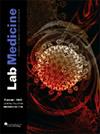Overview of Urea and Creatinine
IF 1
4区 医学
Q4 MEDICAL LABORATORY TECHNOLOGY
引用次数: 96
Abstract
Urea, commonly referred to as blood urea nitrogen (BUN) when measured in the blood, is a product of protein metabolism. BUN is considered a non-protein nitrogenous (NPN) waste product. Amino acids derived from the breakdown of protein are deaminated to produce ammonia. Ammonia is then converted to urea via liver enzymes. Therefore, the concentration of urea is dependent on protein intake, the body’s capacity to catabolize protein, and adequate excretion of urea by the renal system. 1 Urea accounts for the majority (up to 80%-90%) of the NPNs excreted by the body. The body’s dependency on the renal system to excrete urea makes it a useful analyte to evaluate renal function. An increase in BUN can be the result of a diet that is high in protein content or decreased renal excretion.尿素和肌酐概述
尿素,在血液中通常被称为血尿素氮(BUN),是蛋白质代谢的产物。BUN被认为是非蛋白质含氮(NPN)废物。蛋白质分解产生的氨基酸被脱胺生成氨。然后氨通过肝酶转化为尿素。因此,尿素的浓度取决于蛋白质的摄入量、人体分解蛋白质的能力以及肾脏系统对尿素的充分排泄。1尿素占身体排泄的npn的大部分(高达80%-90%)。人体对肾脏系统排泄尿素的依赖使其成为评估肾功能的有用分析物。BUN的增加可能是饮食中蛋白质含量高或肾脏排泄减少的结果。
本文章由计算机程序翻译,如有差异,请以英文原文为准。
求助全文
约1分钟内获得全文
求助全文
来源期刊

Labmedicine
医学-医学实验技术
CiteScore
2.50
自引率
0.00%
发文量
155
审稿时长
>12 weeks
期刊介绍:
Lab Medicine is a peer-reviewed biomedical journal published quarterly by the ASCP and Oxford University Press. The journal invites submission of manuscripts on topics related to clinical chemistry and microbiology, hematology, immunology, transfusion medicine, molecular diagnostics, cytology, histology, and laboratory administration and management. Original research, reviews, and case reports are considered for publication. Lab Medicine is indexed (under the title Laboratory Medicine) by the National Library of Medicine and is included in the PubMed database.
 求助内容:
求助内容: 应助结果提醒方式:
应助结果提醒方式:


